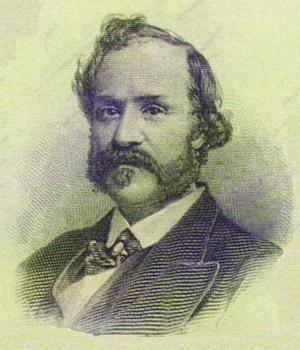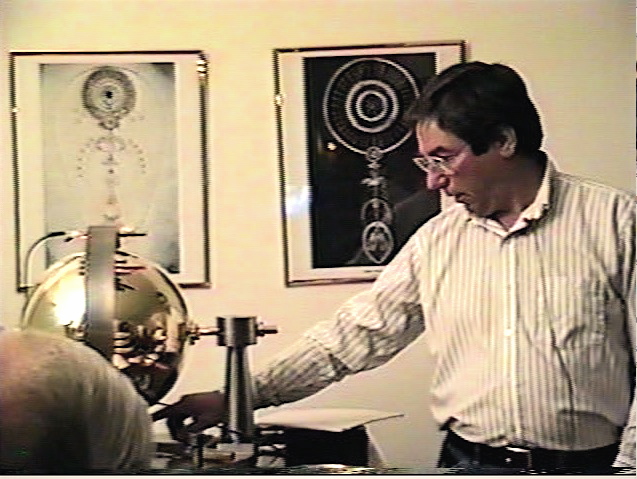| Check out the SVPwiki | SVP Cosmology 2.3 |
NYT - 11/18/1884 - It is unlikely that the ingenious Mr. Keely will be able to extort any further assessment from his stockholders. His reply to the criticisms made in THE TIMES upon his vibratory gun by a hardheaded and hardhearted engineer in that Lieut. Zalinski is "jealous of him." "He feels, as well he may, that "I soar far above him. The difference between us is that of the lion and the lamb." We do not clearly make out whether the lamb soars above the lion or the lion above the lamb. But when the lamb, if the Lieutenant be the lamb, offers to affix a standard gauge to the lions motor for the purpose of testing the lions statement about the pressure developed by "vaporic force" and the lion declines to let him, things begin to look badly for the soaring lion. Mr. Keely appears to be a magnetic engineer. He has an explanation of his failures which is entirely honorable to his motor, but he will not or can not tell anybody what it is, and so his motor and his motives are the objects of cruel misconstruction. He never urges any man into a speculation, but the more he sees and knows of this motor the more confidence he feels in it. He is therefore filled with disgust when an unsympathetic engineer offers to repeat his experiments and produce his results with compressed air. When he announces that his motor will be completed "next February" the faith even of the most steadfast of his stockholders must begin to give way.
THE MOTOR THAT PROVED A FAILURE AT NEWARK
NYT - NEWARK, Dec. 29 ,1884. - In addition to what appeared in THE TIMES today in reference to the Keely motor, a Press reporter has learned some interesting facts. The idea of a motor, Baker, the machinist, avers, was given to Keely in this city as long ago as 1807, when Dr. George Q. Prindham, then of Newark, but now of Philadelphia, constructed a machine in many respects like the Keely motor. It was built at the fire engine works of Gould Brothers. Keely, Baker says, got the idea by haunting the shops of the firm. Since that time the firm has undergone some changes, and is now working under the title of George & Eberhardt. Mr. Eberhardt was interviewed by the reporter today. He said he certainly remembered a machine like the one which Baker claims was made in the shop of Gould Brothers.
"We made the machine for Dr. Prindham, and he spent considerable money and time on it. I also recall that one part of the machinery called for a powerful screw of chilled steel and that we found considerable trouble in bringing it to perfection. The man Baker I cannot recall, but there is a brother of Dr. Prindham employed in the machine shop. I will call him out for to you question.
The young man came, clad in his workmans blouse and with the marks of toil on his hands and face. The circumstances were explained to him and he smiled. "Yes, I remember it all very well," he said. "The Baker you speak of is, I think, very likely A. Beckert, a German we had here. He was employed on work of the kind you mention. It was my brother who tried to get the machine first brought out. A man named Scarttergood one day introduced a tall, lean down Easter to him and said that the Yankee had a wonderful patent, but that he hadnt money enough to bring it out. He wanted to form a stock company, but my Brother said he had money enough to bring the thing out, and together they started on it. My brother often went into ecstasies over the invention, and said it was a big thing and could not fail of being successful. He often told me that all he need do was to put in a quart of so of cold water and the thing would go and be as powerful as a Cortiss engine, while only occupying one-hundredth part of the space and costing only a few hundred dollars."
"Now I remember," said Mr. Eberhardt, who was an attentive listener, interposing at the point. "He intended turning all the shafting in this shop with this power. As you see, it occupies the whole block in front, and to a considerable distance back. The inventor, the long, lean man, whose name I cannot now recall, said that it had the power of 100 horses at least."
What was the appearance of the machinery?" inquired the reporter.
"Well, it was an elaborate affair, with a big cylinder, like the description of Keelys machine. It had a small engine attached to it. He used to put some cyanide of potassium into the pipes and make the thing go, which it would for a short time. Then it would stop and something would be declared out of order and the doctor would have to shell out again. Finally, my brother gave it up in despair and would have no more to do with it. It cost him $300 for the making of the machine lever, and for the other parts of it - the patent, and all that - he must have paid out $700 or $800 more. Finally, he threw the whole up and--"
"And," said Mr. Eberhardt, laughing, " I believe there are some parts of it around here, and much more of it has since been burned up and used."
"Do you remember the name of the patentee?" asked the reporter.
"I do not." Mr. Prindham said. "I am of the opinion, however, that the machine is the same one that is now at work in Philadelphia. It is very likely that the inventor who caused the doctor to invest in it is now with Keely working the same racket in Philadelphia."
"Was Keely ever here in these works?"
"Yes, I have seen him around the shop, I think. He was in Newark certainly, but where there are 175 men on one floor of a shop it is almost impossible to remember the names of those who have worked here and left. But I am of the opinion that Keely has been around the shop at one time or another."
Philadelphia
The Daily News - 5/26/1886 - For a number of years Mr. John W. Keely, of this city, and various associates have occupied the attention of the public to a greater or less extent, from time to time. The claim on behalf of Mr. Keely is that he has discovered a new motive power, so far transcending all previous achievements in this direction, as to overturn most of the universally recognized conclusions regarding dynamics. Of course such a claim was sure to be met with derision, and the derision was sure of continuance until silenced by the most thorough practical demonstration.
"Discussion of the matter has not seemed profitable in the absence of such a demonstration; but now it seems proper to note an apparently new status of Mr. Keelys affairs, as shown by some experiments conducted last Saturday in the presence of a number of visitors. Some, at least, of these visitors were qualified for critical observation, and the noteworthy fact is that Mr. Keely was able to produce, under their close inspection, a dynamic result which none of them pretended to account for by any known law of physics, outside of that which Mr. Keely claims as the base of his operation. He evolved, almost instantaneously, according to the united report of those who were present, a substance having an elastic energy varying from 10,000 to 20,000 pounds per square inch, and instantly discharged or liberated it into the atmosphere, without the evolution of heat in its production, or of cold on its sudden liberation. These phenomena alone would seem to establish that the substance he is dealing with is one hitherto unknown to science.
"It seems rather frivolous to dismiss this matter with the supposition that trained specialists are to be hoodwinked by concealed springs, buried pipes for the introduction of compressed air and the like. Surely such gentlemen ought very easily to determine at once whether the surroundings and conditions of the experiments were such as to favor any kind of legerdemain; and if they found them so, it is strange that they should spend some hours in investigating that which has been asserted to be a transparent humbug.
"The appearances are that Mr. Keely has at least removed his enterprise from the domain of ridicule to that of respectful investigation, and this, after all, is great progress."
1/19/1896 - Keely has given another exhibition of what he calls his "polar-depolar sympathetic force" or "the interchange of polar and depolar sympathy." Copper globes were made to revolve in response to the notes of a tuning fork or a zither and guests were permitted to look at the new motor, which, like those which have preceded it in Keelys workshop during the last twenty years, is "not quite finished." This motor, a great mass of steel, "will so neutralize the force of gravity," Keely says, "that a child will be able to pick it up and hold it at arms length." After it shall have been completed he will "run a street car crowded to the roof" with a reduced copy of it "no bigger than your hand."
We notice in the reports of this latest manifestation, that the aged inventor made a very significant remark. "I am always a good deal disturbed when I begin one of these exhibitions," said Keely, "for sometimes, if an unsympathetic person is present, the machines will not work." How many times have Spiritualist "mediums" said the same thing! How many times have they accounted for failure by explaining that the spirits were repelled by some unsympathetic person in the audience or "circle"! The most loyal and generous of Keelys patrons now believes, it is reported, that the motive power he has discovered is "the will of God," and that the old man can move railroad trains and other things by word of mouth without the aid of any machinery whatever. This appears to be the substance of his explanations to his intimate friends.
Keely now admits that he is working on a new basis or hypothesis. Do not his latest allusion to the adverse influence of unsympathetic or unbelieving persons foreshadow a coming explanation that his occult force is really supplied from the spirit world?
 |
||
 |